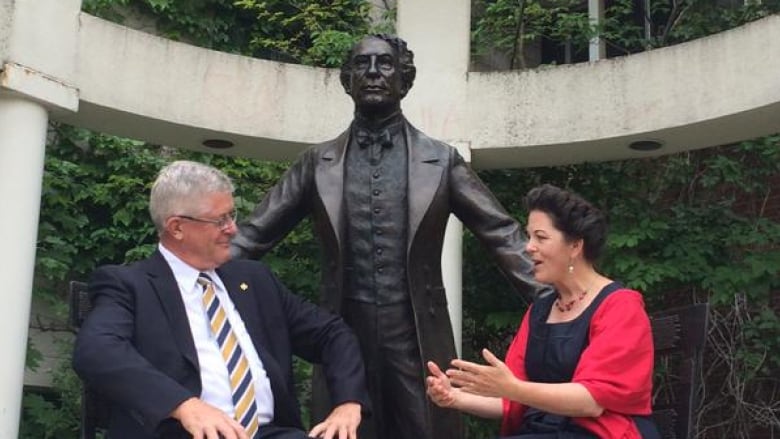Wilfrid Laurier University nixes prime minister statues project
School will remove existing Sir John A. Macdonald statue

Wilfrid Laurier University's board of governors voted Wednesday night to withdraw from an agreement to put statues of 22 ofCanada's pastprime ministers at the school, months after the school first announced it would go ahead with the controversial project.
WLU approved an agreement with a citizens' group in June of 2015 to put the statues at the school'sWaterloo, Ont. campus and a bronze statue of Sir John A. Macdonald was moved into the Waterlooquad.
Now, the school has voted towithdraw from the agreement, and will move the Sir John A. Macdonald statue from its temporary location.
"The university will engage in discussions to collaboratively work toward a resolution to exit the statues project, and specific details are not known at this point," wrote university spokeswoman Lori ChalmersMorrison in an email to CBC News, when asked if the school would face a financial penalty for the withdrawal.
As for the statue of Canada's first prime minister,"discussions will take place to determine future plans for the statue," she wrote.
Project meant to mark Canada's 150th
Jim Rodger, a former Kitchener-Waterloo Collegiate principal and Sandvine CEO Dave Caputo led the group behind the project. The group has been raising money and wanted the statues ready for 2017, to celebrate Canada's sesquicentennial 150 years since Confederation.
"We are in the process of reviewing the situation. At this time, we have not met with WLU so it would be premature to comment further," said JimRodgerin anemailto CBC News Friday about the decision.
Governor general David Johnston was also a supporter of the plan.
The controversial project was originally proposed forKitchener'sVictoria Park, but citycouncillorsvoted against it in March of 2014 after public outcry.
Statuecontroversy
The PM project hasattracted muchattention and debate, including supportiveeditorials in the National Post, op eds in The Toronto Star and The Globe and Mail, toduellingonlinepetitions both supporting and opposing the statues.
After the statues project was approved in June, opponents started an online petition in July to stop it. The project'sdetractors saidthat celebrating the country's prime ministers with statues would be culturally insensitive, and that there was a lack of consultation before the project was approved.
"It is politically and culturally insensitive (if not offensive) to celebrate and memorialize all Canadian Prime Ministers in the form of bronze statues on land that traditionally belongs to the Neutral, Anishnawbe and Haudenosaunee peoples," wrote Jonathan Finn on the introduction to the online petition in opposition to the statue project.
"In our view, consultation and debate should precede rather than follow the decision to proceed with such a large-scale public art installation that will significantly, and lastingly, transform the cultural landscape of the Waterloo campus."
Laurier has campuses in both Waterloo and Brantford, Ontario.
Winter of discontent
In October, after the WLU's senate heard concerns over the project, theypassed a motion opposing the project, and recommendedthe board of governors halt the school'sinvolvement.
In November, Laurier President MaxBlouwannounced that the school would createa specialspecial advisory committee to review the project. The committeeheld a public consultations process that received81 written submissions, 13 community presentations andtwo invited presentations.
At the end of January 2016, the committee submitted a report that recommended the school withdraw from the project.












_(720p).jpg)


 OFFICIAL HD MUSIC VIDEO.jpg)
.jpg)



























































































